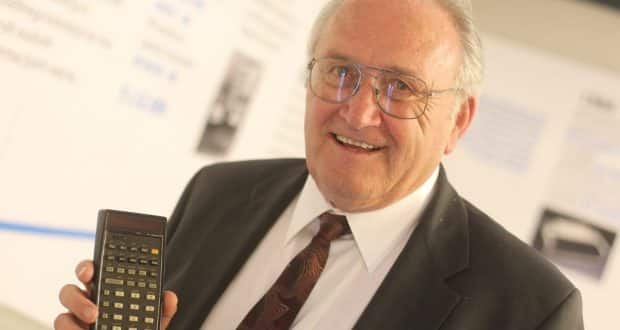France Rode, inventor of pocket calculator HP-35
As a young electrical engineer, France Rode (1934-2017) joined Hewlett-Packard, where he worked on the team that invented the first pocket calculator. This was only one of his many ground-breaking achievements facilitating the development of modern electronics in what has since become known as Silicon Valley.
Rode left Yugoslavia for the US in 1960 after graduating in electro-mechanics in Slovenia’s capital Ljubljana. Although many were leaving for ideological reasons, Rode did it for love; his Slovenian high-school sweetheart had moved to Chicago.
He thus became one of the many Slovenian engineers and inventors who made a name for themselves abroad. He is a holder of more than 20 patents in the fields of calculators, satellite navigation and radio-frequency identification.
However, as he explained in an interview published in the 2003 book “Strast po znanju in spoznavanju” (Passion for Knowledge and Learning), he considered his biggest achievement the entire body of his work related to calculators, including the HP-35, HP-80 and a “briefcase computer”, a predecessor of the laptop. He was happy to have been able to take part in creating a new computer industry, as well as facilitating the work of engineers and other computer users.
The HP-35 was placed on the market in the early 1970s as the first hand-held scientific calculator. It enabled engineers to replace the slide rule, which they used for complex calculations, opening the door to a new genre of pocket calculators and consumer electronics.
Before the HP-35 was invented, Hewlett-Packard was already selling a personal computer. But one day Bill Hewlett came to the laboratory to see the 20-kg calculator HP had designed, saying he would like to have one that would fit his shirt-pocket, Rode recalled once.
The engineers quickly measured his pocket and designed the HP-35. It took many new ideas and inventions to design it, including a miniature processor, which was one of Rode‘s contributions to this commercially extremely successful product.
While he did not receive the recognition of having designed the first microprocessor in the world, Rode‘s HP-35 calculating unit had all the characteristics associated with a microprocessor, including an extensive instruction set.
HP-35 calculators were hailed as a “prime example of advanced US technology”, and were taken by President Richard Nixon on his historical 1972 visit to China. Its legendary status was acknowledged by the IEEE, a leading association of technical professionals, by declaring it a milestone in electrical engineering and computing in 2009.
Following the success of HP-35, Rode was assigned to lead the team which developed HP-80, a series of calculators for businesses used to compute mortgages, returns on investments and other business transactions. While William Crowley contributed the algorithms, Rode encoded them into the hardware.
After 1978, Rode also headed the development of a predecessor of today’s laptop – what HP called a “briefcase computer”. According to Rode, the team designed everything a portable computer would need, but the problem was the screen.
There was just not enough light on the screen, so the project was shelved until an LED screen appeared on the market, yet the engineers nevertheless spearheaded HP’s development of laptops.
In 1982, Rode left HP after 20 years to start his own business, developing wireless electronic locks based on radio-frequency identification (RFID) technology; he created workplace entry cards, the microchips for which were developed at the University of Ljubljana and manufactured by the Slovenian firm Iskra.
He also took part in Trimble Navigation’s research into the use of the new satellite-based navigation GPS in airplanes, as well as attempts to redesign and integrate the GPS receiver, which later led to integrated circuits for navigation being used in mobile phones or cars.
According to Slovenian Science Foundation director Edvard Kobal, as a pioneer in digital electronics, computer science and measuring instruments, Rode had a talent for developing completely new solutions in electronic measuring instruments and for upgrading the existing ones.
Rode retired in 2008. Despite having spent most of his life in the US, he was closely attached to Slovenia, where he also earned his PhD in electro-mechanics in 1975. He said in an interview that when he was going to Slovenia he was going home.
He was born into a farming family in the region of Gorenjsko as the oldest of four children and graduated from the Ljubljana Faculty of Electrical Engineering in 1960. Even before his graduation, he had applied to study at Northwestern University, and he boarded a ship for the US the same year.
He earned a master’s degree in biomedical engineering from Northwestern University in the state of Illinois in 1962, where he was assigned to an unusual research project – “inventing” a device to hypnotise people.
Unable to find a job there, allegedly because of his Yugoslav origin, he was advised to apply for a job at Hewlett-Packard in Palo Alto in California. He joined the company in late 1962 and contributed to its success with another Slovenian scientist, Zvonko Fazarinc.
Portraits of both Rode and Fazarinc were published in Edward Gobetz’s 2016 book Slovenian American Inventors and Innovators.
Just a few weeks before he died this June, Rode was named an honorary member of the Slovenian Chamber of Engineers and was received by President Borut Pahor.
He was married to Mia Gaber, with whom he had two daughters. He was a relative of another well-known Slovenian, Cardinal Franc Rode; their grandfathers were brothers.
Source: sta.si


